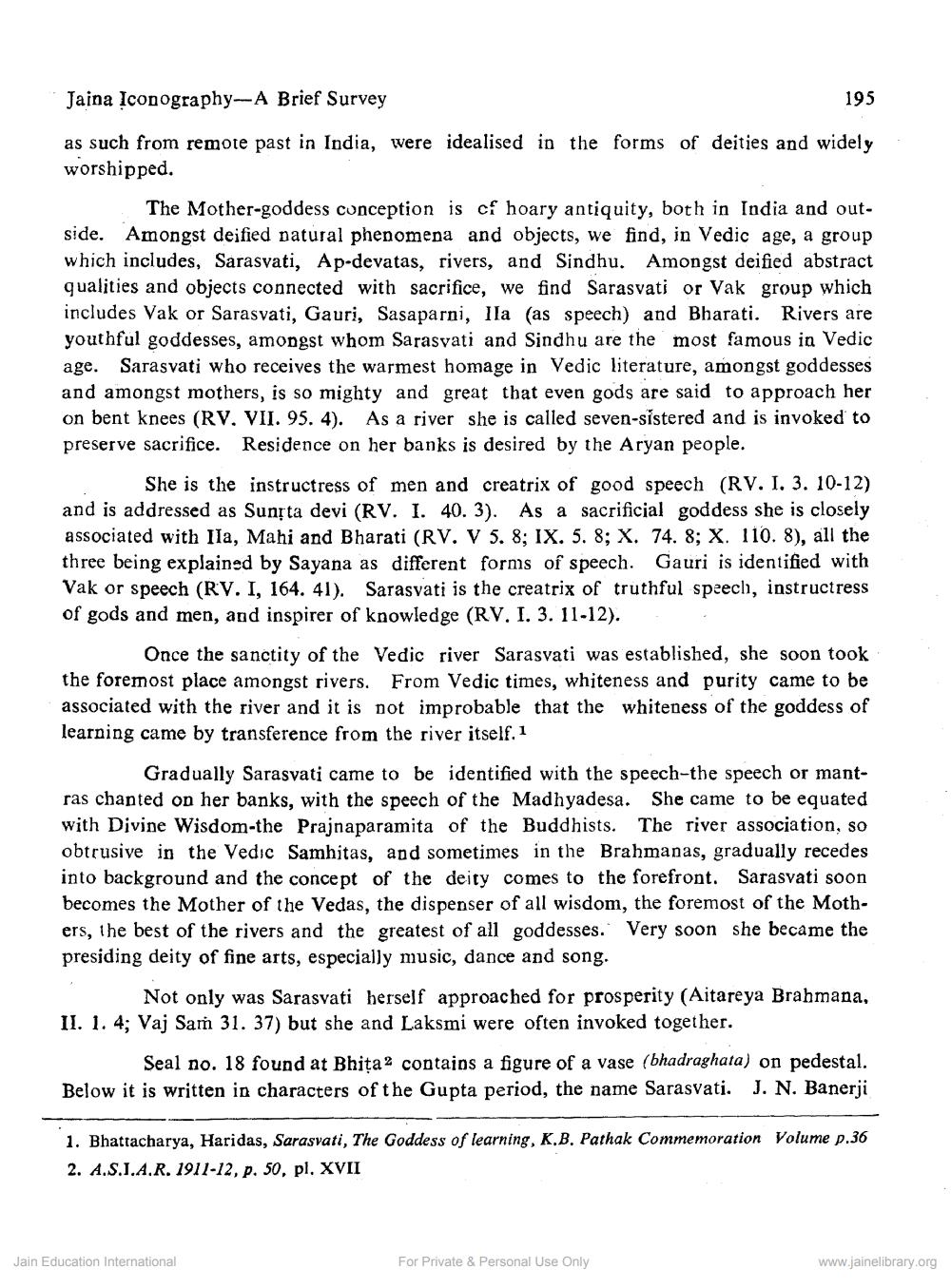________________
Jaina Iconography-A Brief Survey
as such from remote past in India, were idealised in the forms of deities and widely worshipped.
The Mother-goddess conception is cf hoary antiquity, both in India and outside. Amongst deified natural phenomena and objects, we find, in Vedic age, a group which includes, Sarasvati, Ap-devatas, rivers, and Sindhu. Amongst deified abstract qualities and objects connected with sacrifice, we find Sarasvati or Vak group which includes Vak or Sarasvati, Gauri, Sasaparni, Ila (as speech) and Bharati. Rivers are youthful goddesses, amongst whom Sarasvati and Sindhu are the most famous in Vedic age. Sarasvati who receives the warmest homage in Vedic literature, amongst goddesses. and amongst mothers, is so mighty and great that even gods are said to approach her on bent knees (RV. VII. 95. 4). As a river she is called seven-sistered and is invoked to preserve sacrifice. Residence on her banks is desired by the Aryan people.
195
She is the instructress of men and creatrix of good speech (RV. I. 3. 10-12) and is addressed as Sunṛta devi (RV. I. 40. 3). As a sacrificial goddess she is closely associated with Ila, Mahi and Bharati (RV. V 5. 8; IX. 5. 8; X. 74. 8; X. 110. 8), all the three being explained by Sayana as different forms of speech. Gauri is identified with Vak or speech (RV. I, 164. 41). Sarasvati is the creatrix of truthful speech, instructress of gods and men, and inspirer of knowledge (RV. I. 3. 11-12).
Once the sanctity of the Vedic river Sarasvati was established, she soon took the foremost place amongst rivers. From Vedic times, whiteness and purity came to be associated with the river and it is not improbable that the whiteness of the goddess of learning came by transference from the river itself.1
Gradually Sarasvati came to be identified with the speech-the speech or mantras chanted on her banks, with the speech of the Madhyadesa. She came to be equated with Divine Wisdom-the Prajnaparamita of the Buddhists. The river association, so obtrusive in the Vedic Samhitas, and sometimes in the Brahmanas, gradually recedes into background and the concept of the deity comes to the forefront. Sarasvati soon becomes the Mother of the Vedas, the dispenser of all wisdom, the foremost of the Mothers, the best of the rivers and the greatest of all goddesses. Very soon she became the presiding deity of fine arts, especially music, dance and song.
Not only was Sarasvati herself approached for prosperity (Aitareya Brahmana. II. 1. 4; Vaj Sam 31. 37) but she and Laksmi were often invoked together.
Seal no. 18 found at Bhita contains a figure of a vase (bhadraghata) on pedestal. Below it is written in characters of the Gupta period, the name Sarasvati. J. N. Banerji
1. Bhattacharya, Haridas, Sarasvati, The Goddess of learning, K.B. Pathak Commemoration Volume p.36 2. A.S.I.A.R. 1911-12, p. 50, pl. XVII
Jain Education International
For Private & Personal Use Only
www.jainelibrary.org




